Search in our Business Database
Savannakhet, Lao PDR
Welcome to Savannakhet
Savannakhét (Lao:ສະຫວັນນະເຂດ) is a province of Laos. The name Savannakhet derives from Savanh Nakhone, which means “city of paradise”, the province’s original name. It was established in 1642. The town was bombed and then occupied by Thai armed forces during the French-Thai War. This province is located in the south of the country. It is located just across the Mekong river from Mukdahan, Thailand. It’s 487 kms (247 miles) south of the capital Vientiane, 884 kms (549 miles) from LuangPrabang and 236 kms (145 miles) north of Pakse city. It is bordered by Khammouan to the north, Salavan to the south, Quang Tri and Thua Thien-Hue of Vietnam to the east and Nakhon Phanom and Mukdahan.
What is the best time to visit Savannakhet?
Savannakhet features a tropical wet and dry climate, with generally very warm weather throughout the year. The city does feature warmer and cooler periods of the year, with average temperatures ranging from 22 C in January, to 29 C in March. Savannakhet has discernable wet and dry seasons, with the wet season covering April through October and the dry season covering the remaining five months.
Business Associations
| Leading Entrepreneur(s)/Company(ies) | Type of activity/services |
|
Savannakhet Chamber of Commerce and Industry Address: Oudomsinh Road, Sunantha Village Kaisone District, Savannakhet Province, Lao PDR Tel : +856 41 253 325 Fax: +856 41 253 326 E-mail: [email protected] Contact Person: Mr. Keomano Khounkeoouthoum Secretary General |
Organize meetings with members, organize and develop clusters, provide consultancy and trade informations, issue certificate of origin, and provide trainings |
| Wood Processing Industrial Manufacture Association Address: Wood Processing Somchith Product Kaisone District, Savannakhet Province, Lao PDR Tel/Fax: +856 41 213 165 Mobile: +856 20 555 40 117, +856 20 2230 8222 Contact Person: Mr. Somchith Soulignong |
|
| Trading Enterprise Import –Export Group Address: KIKO Partnership Trading Co., Ltd. Latsavongseuk Road, Sunantha Village, Kaisone District, Savannakhet Province, Lao PDR Tel: +856 41 212 269 Fax: +856 41 213700 Mobile: +865 20 5554 1233 Contact Address: Mr. Siaosavath CHOUNLAMOUNTRY |
|
| Land – Navi Transportation Address: VISAY CHALEUN Trading Limited Export-Import Oudomsinh Road, Sunantha Village, Kaisone Distrcit, Savannakhet Province, Lao PDR Tel: + 856 30 967 6615 Fax: + 856 41 252 196 Mobile: + 856 20 5564 3765 Contact Person: Mr. Visay SOMCHALEUN |
|
Demographic Profile
Savannakhet has 12 different ethnic groups; the city is mixed of Lao, Thai, Chinese and Vietnamese communities, as well as minority peoples from the Lao interior.
The section on business environment will give you an indication of the labour cost in this province. The languages spoken in this province includes Lao, Tai Dam, Thai, Vietnamese and Chinese.
Economic Zones
In order to gain maximum benefit from the implementation of the EWC, the Lao Government has decided to establish the first Special Economic Zone in Lao PDR.
Savan-Seno Special Economic Zone (SSEZ) is geographically composed of two separate sites both located in Savannakhet Province:
• Site A (305 ha), located immediately upstream of Savannakhet capital city (Khanthabouly) and next to the new Mekong River Bridge, the construction of which will start in 2003.
• Site B (20 ha) at Seno town located 28 km East from Khanthabouly city, at the junction between the National Road No. 13 and National Road No. 9

SSEZ is located around the mid-way point along Road No.13 from China to Cambodia. That means it is at the junction between the East-West axis and the North-South axis linking the most populous countries in the Asian region, and thus is a prime center for trade and services for the neighboring countries, which include China (Yunnan Province), Myanmar, Thailand, Cambodia and Vietnam, with a total population of more than 500 million people.
Government is planning to upgrade the existing domestic airport in Khanthabouly city of Savannakhet province into an international airport in the near future, in order to meet transportation requirements of passengers and goods. The categories of business activities planned to be develop in the SSEZ include the following:
- Export Processing Zone;
- Free Trade Zone;
- Free Service and Logistic Center (which should include tourism, banking and other activities)
Regulations on the SSEZ, which are under preparation to be adopted by the Government and National Assembly by early 2003, will be designed to successful attract local and foreign investment to the Zone. The SSEZ governance is the responsibility of the SSEZ Authority (SEZA). The primary function of the Authority will be to ensure prompt and transparent authorization of licensing of investment in the Zone and to provide investors and developers with all necessary facilities and assistance, including processing of their investment requests through a One-stop Station Service. The SSEZ has an autonomous budget and full responsibility in the management, design and construction of the Zone.
| Contact Address for Industrial Zones | |
|
1. Department of Domestic and Foreign Investment (DDFI) Luang Prabang Rd., Vientiane 01001, Lao PDR Tel: (856 21) 222690; 222691; 217005 Fax: (856 21) 215491 E-mail: [email protected] Website: http://www.invest.laopdr.org/ |
2. Savan-Seno Special Economic Zone Authority |
|
3. SAVAN Park Savannakhet |
4. Department of Planning and Investment, Savanakhet Tel: +856 41 215042 +856 41 212163 Fax: +856 41 215042 Email: [email protected] website: www.dpisavan.com |
|
5. SCCI (Savannakhet Chamber of Commerce and Industry) |
|
Financial Service
In mid 1990, a law to establish the Bank of the Lao PDR was enacted. The law determines the role of the bank under the new system.
At the beginning of 1992, provisions were made to protect the gradual evolution of the banking and financial sector until they were able to accept autonomy on the same basis at the international banking and finance community. Meanwhile, the government began to allow foreigners to play a role in the banking business in terms of joint ventures and the opening of branches or agencies. However, their activities were restricted to Vientiane Municipality.
Under the guide and the supervision of the Bank of the Lao PDR, there are 34 commercial banks and branches including domestic and foreign banks. These banks can be characterized as specialized and general commercial banks. While general banks deal with deposits or handle short and long term support funds for investment, they also supply business with working capital needed to back up production activities.
Under the supervision of the Bank of the Lao PDR, the
commercial banks located throughout the territory are as follows:
State-owned bank
- Bank of Foreign Trade : head office in Vientiane, two branches in Savannakhet and Pakse
- Sethathirath Bank : head office in Vientiane, two branches in Phonehong and Paksane
- Phaktai Bank : head office in Pakse
- Nakhorn Luang Bank in Vientiane
- Aloun Mai Bank, regional bank with office in Xamneua
- Lao Mai Bank, regional bank with head office in Savannakhet
- Lane Xang Bank, head office in Luangprabang
- Agricultural Promotion Bank, head office in Vientiane
Joint Venture Bank
- Vientiane Commercial Bank
- Joint Development Bank
Foreign bank and branches
- Public Bank, Malaysian branch
- Standard Chartered Bank
- Bangkok Bank branch
- Siam Commercial Bank branch
- Krung Thai Bank branch
- Thai Farmer’s Bank branch
- Thai Military Bank branch
- Ayudhaya Bank branch
| Main Financial Institution in the Province | |
| Banque Lao Pour Le Commerce Exterieur Tel : + 856 41 212 261, 215 048 Fax: +856 41 212 723 Module : +856 20 556 40341 www.bcel.com.la Sunantha Village, Savannakhet Province, Lao PDR |
Electronic banking, ATM, Deposit service, Fund transferring service, letter of credit services and other extra services. |
|
ST Bank |
Complete financial service for society to acquire capital both domestic and abroad and then provide loans to all business sectors |
Infrastructure Facilities

By plane
Savannakhet has an airport, located not far from down-town. Lao Airlines, which is the only domestic Laos carrier, used to offer direct flights from and to Vientiane. Nowadays, Vientiane can only be reached by flying via Pakse, a trip that totally takes two and half hours.
By bus
There is bus service from Vientiane to Savannakhet. For the time being it is the only way to practically get to Savannakhet from the capital. It is a 9 hour bus ride on a newly paved road. While the ride is long, it is an excellent way to see the local villages and lush country side of Laos. Buses from Vientiane to Pakse, often stop in Savannakhet.
International
The Second Thai–Lao Friendship Bridge across the Mekong to Muakdahan, Thailand, opened to the general public on January 9, 2007. There is a regular bus service between Mukdahan and Savannakhet, with departures approximately once an hour.
VIP buses to Dong Ha in Vietnam go via Lao Bao, and are only available on weekdays at 10am. The 350 km trip takes around seven hours. Also, VIP buses to Hue (Vietnam) leave on weekdays only at 10am. The 410 km journey takes eight hours.
Investment Opportunities
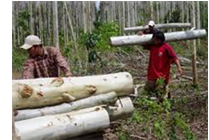 Law on the Promotion of Foreign Investment no.02/ NA (200) has Welcomed every business sector and activity not detrimental to national security, environment, and public health and safety.
Law on the Promotion of Foreign Investment no.02/ NA (200) has Welcomed every business sector and activity not detrimental to national security, environment, and public health and safety.
The conditions for investment incentive on tax depends on each zone and the class of investment especially referring to the government’s priorities, poverty reduction, enhancing the people’s quality of lives, infrastructure, human resource development, job opportunities and others….
| Zone | 1st Class | 2nd Class | 3rd Class |
| Zone I | 10 years | 6 years | 4 years |
| Zone II | 6 years | 4 years | 2 years |
| Zone III | 4years | 2 years | 1 years |
-
Special Investment Incentives
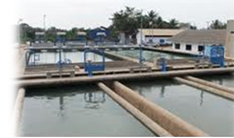 Construction investment of hospitals, kindergartens, schools, vocational schools, colleges, universities, research and analysis institutions, some of public utility are eligible for additional investment incentives as following:
Construction investment of hospitals, kindergartens, schools, vocational schools, colleges, universities, research and analysis institutions, some of public utility are eligible for additional investment incentives as following:- Land lease or concession exemption:
- Zone 1 = 15 years Zone 2 = 10 years Zone 3 = 3 years
- Additional profit tax exemption for 5 years
-
Other Incentives
- Exemption of import duties and taxes on raw materials and capital equipment
- Exemption of export duty on export products
- Foreigners who invest not less than 500,000 USD in Laos will gain right to purchase land
- Remittance of dividends and profits back home or to third countries is allowed through banking system
- Concession duration is up to 99 years
- Duration for general business investment is unlimited
- Investment capital for general business is not less than 1 billion kip
- Registered capital for concession business is not less than 30% of total capital
-
One Stop Service (OSS)
- For concession business, OSS unit is available at the Department of Planning and Investment
- For general business, OSS unit is available at the Department of Industry and Commerce
- For any business investing in the special economic and specific economic zones, ODD unit is available at the Special Economic Office
Attractive Business Sectors:
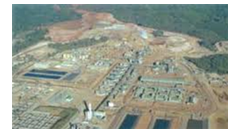
Mining
In fact Laos has substantial potential in mineral ores where occurrences of gold, tin, iron lead, zinc, precious stones, coal, lignite, limestone, gypsum, etc., have been identified in many parts of the country.
Energy
Laos has also substantial potential from its water resources for hydropower generation. Many tributaries of the Mekong River offer possibilities for the construction of dams and reservoirs to produce low-cost electric energy for export to neighbouring countries, in which the demand for power has increased abruptly year after year. It is estimated that the country possesses over 18,000 MW of hydropower installed capacity, of which only 2 percents has been so far developed. The government promotes the development of hydropower projects in many locations throughout the country.
Agribusiness
Plains and plateaus offer possibilities for development of agriculture and livestock. Coffee, cotton, sugar, fruits and vegetables can be grown under good soil and climatic conditions. The Lao Government gives special privileges to develop the agricultural sector and investors are invited to bring into the country their capital, know-how and techniques to develop agro-based production for export.
Agriculture
The economic growth of the Lao PDR depends to a large extent upon the performance of the agricultural sector, which contributed 51% of the GDP in 1997. Coffee is by far the most promising product for export.
Forestry
It has been estimated that the Lao PDR has the highest ratio of forest to total area in Asia. Wood products including lumber are one of the main export earners of the Lao PDR.
Light Industry
In the industrial sector, besides mining and hydro energy development, light manufacturing industries such as garments, wood-based semi and finished products, and high value-added goods can be produced for export by using cheap electric energy and local labor. Laos is a "Generalized System of Preference" (GSP) receiving country for many markets in the world.
Transport
In Laos, transportation infrastructure is inadequate and considered a major impediment to trade, co-operation and the exploitation of rich mineral resources, particularly those located in the hinterland.
Tourism and Hostelry
Small-scale tourism is also being promoted. The country is endowed with many historical and natural sites.
Service
In the field of services investment in banking, insurance, transportation, communications, hostelry and trade are encouraged.
Logistic Provider
There are few transport companies for people transportation, and some for good transportation, both domestic and international. Very few warehouse facilities. Savannakhet airport is currently planning to set up a cargo and a warehouse service.

| Leading Entrepreneur(s)/Company(ies) | Type of activity/services |
| Land – River Transport Co Ltd 03 PhokaduatSt Phonsay Savannakhet Province, Lao PDR Contact Number: +856-41 2121 62 |
Land-River transportation |
| Lao Transportation Service Co (Savannakhet Branch) Oudomvilay Contact Number: +856-41 2123 09 |
Transport |
| Land Transportation & Technical Vehicle Service Centre 311 40 XaiNyaphoum, Savannakhet Province Contact Number:+856-41 2120 56 |
Transport |
Macro Economic
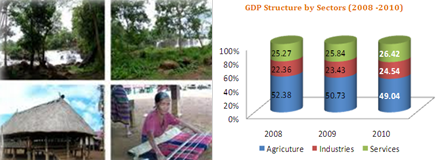
In 2010, the average Gross Domestic Product (GDP) of Savannakhet province was around 984 USD per person per year with the increase of 10.52 % per year since 2005.
| Key Business Sectors in Savannakhet | |
| Sector | Importance |
| Agriculture |
|
| Manufacturing |
|
| Agro-processing | Sugar-processing plants, beer and drinks processing plants, cassava powder processing plant, eucalyptus paper processing plant, tobacco (red flower) processing plant. |
Natural Resources
In fact Laos has substantial potential in mineral ores where occurrences of gold, tin, iron lead, zinc, precious stones, coal, lignite, limestone, gypsum, etc., have been identified in many parts of the country.
Laos has also substantial potential from its water resources for hydropower generation.
Plains and plateaus offer possibilities for development of agriculture and livestock. Coffee, cotton, sugar, fruits and vegetables can be grown under good soil and climatic conditions. Wood products including lumber are one of the main export earners of the Lao PDR.
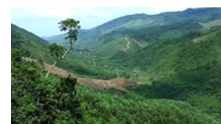
Opportunities in Tourism
 In 2009, Savannakhet province and Savannakhet city were the first entry point in Lao in term of number of entry, with about 670.000 entries, above Vientiane capital. About 50% of the entry is dedicated to casino. Most of the remaining tourists are only transiting through Savannakhet, to go or in the South, or in the North, or in Vietnam. The big majority of the tourism in Savannakhet is Asiatic.
In 2009, Savannakhet province and Savannakhet city were the first entry point in Lao in term of number of entry, with about 670.000 entries, above Vientiane capital. About 50% of the entry is dedicated to casino. Most of the remaining tourists are only transiting through Savannakhet, to go or in the South, or in the North, or in Vietnam. The big majority of the tourism in Savannakhet is Asiatic.
Province is gradually created its own niche in maintaining the tourist attractions for it has 55 tourist sites in Savannakhet provinces, divided in 3 categories:
39 natural sites
12 cultural sites
4 historical sites
Other attractions across Savannakhet and the area surrounding includes That Ing Hang Stupa, one of the most sacred Buddhist sites in Southern Laos or Northern Thailand, Wat Sayaphoum Temple, several sites with Dinosaur fossils, Heuan Hin Stone Temple, an outpost of the Khmer civilization and more than 1,000 years old, Hor Tai Pitok Ancient Library, a 200 year old wooden house and home to many stunning palm leaf scripts and the Lam Seun 719 Battlefield.
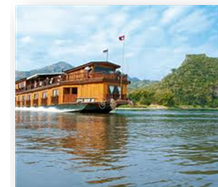
Savannakhet’s true strength is in eco-tourism such as that found in the Dong Natad Provincial Conservation Area, the Phu Xang Hae National Biodiversity Conservation Area, the Dong Phu Vieng National Biodiversity Conservation Center, Bane Don Muang Primate Conservation area, Mai Te Kha Nature Trail in Houei Nhang Forest Reserve, Tad Salaen Waterfalls and Don Daeng Turtle Lake.
Savannakhet is not yet developed. Tourism resources are not yet as prevalent as in Vientiane, Pakse or Luang Prabang and certainly not as much as those in Mukdahan, Thailand. Business resources through the Savan-Seno SEZ are still not as developed nor is business infrastructure of what either the authorities or many businesses can seek.
Other Services
Brief Description of the other services in the province:
Service represent about 25% of provincial GDP
| Major Services | Leading Entrepreneur (s)/Company(ies): | Export | |
| – Service 1: Import Export Services |
Name: | Khouanchay Import-Export Agency4 | Yes, No |
| Contact number: | +856-41 2532 62 | ||
| Address: | 155 05 SisavangvongSt Sounantha Savannakhet Pro. | ||
| – Service 2: Tour Operator |
Name: | Savan Ban Hao | Yes |
| Contact number: |
Tel: (856- 41) 212 202 Fax: (856- 41) 212 202 Email: \n [email protected] |
No | |
| Address: | Ban Xaiyaphoum, Kaisone Phonvihane District |
||
| – Service 3: Construction companies |
Name: | Savankham Construction | Yes |
| Contact number: | Tel & Fax: +856-41 2515 59 Tel & Fax: +856-41 2135 59 |
No | |
| Address: | 16/46 02 Latsavongseuk Street LattanalangsiNeua, Savannakhet Pro., Lao PDR | ||
| – Service 4: Entertainment |
Name: | Savan Vegas Hotel & Casino | Yes |
| Contact number: |
Tel: (856- 41) 252 200-04, 252 141 Fax: (856- 41) 252 142 Email: \n [email protected] This email address is being protected from spambots. You need JavaScript enabled to view it. Website: www SavanVegas.com |
No | |
| Address: | Ban Nongdern, Kaisone Phonvihane District |
||
| – Service 5: | Name: | ||
| Contact number: | |||
| Address: | |||
|
Clusters: Because of its 2 border points (Vietnam and Thailand), because of road no 9, and because of its production both in mineral and in manufactured goods, can become a hub for tradings with the neighbouring countries.
Moreover, the facilities that will be needed along road no 9 to support SaSEZ and the trade along EWEC will enhance the construction sector. |
|||
Research and Development
There are some institutions related to Business issues as follows:
Savannakhet University
Savan Institute of Management (SIM), Website: www.sim.edu.la
Savannakhet Business Administration College
Why invest in Savannakhet
Savannakhet Province in Lao PDR is a thriving hub of trade and services in the Greater Mekong Sub-region (GMS). The province is located along the East-West Corridor (EWC) linking Thailand, Lao PDR, and Vietnam (Road No.9). It is also along the North-South axis (Road No.13) that runs through Lao PDR, leading north into China and South into Cambodia.
Road and bridge construction will further develop Savannakhet as a trade and services zone. Road No.9 is being improved thank to international assistance from Japan. Once the improvement work is completed by 2004, this road will shorten the transport time between Savannakhet and central Vietnam.

In 2007, the Second Thai-Lao Friendship Bridge across the Mekong River from Savannakhet to Mukdahan, Thailand was opened. This is basically a transit point on the way from/to Pakse, Thailand (Mukdahan) or Vietnam (Lao Bao) and is a very nice & relaxing one.
Factors for investments in Laos are:
Political stability
Plenty of natural resources, all of which could be developed and utilized, including forests, mineral, tourist attractions, sources of energy, and also refers to the country’s cultural arts as well as its beautiful nature
Manufacturing inputs at cheaper prices like labor, agro-products, electricity, land rents
Improved economic management mechanism and structure, by Establishing three economic zones.
The northern zone focused on development of livestock, tourism and energy,
The central zone on trading and industry,
and the southern zone on agriculture, trading and tourism.
Enacting laws on foreign investment promotion, business and labor; and
Promoting the role of the private sector in terms of protection, deregulation, decentralization and cooperation.
Privileges given to low export countries. Countries such as the European Community and Japan have granted Laos trading privileges such as tax exemption on imports where over 200 listed items are under a special quota
Flexible financial system
Removed controls over prices. Prices now rely upon market value and enable the private sector to determine wage rates and set prices itself
Business Development in Lao PDR
Since 1986 the Lao Government has introduced and open-door policy and has taken a number of measures to achieve a market economy by reforming its administrative structure and policy accordingly. Following the open-door policy, in 1988 the Lao Government adopted a code for foreign direct investment (FDI), hoping to have revenue generated and job opportunities created in the country.
In parallel to the FDI, the government has begun to transform the centrally planned economy into the market one by fostering the private sector and reforming the public administrative machinery.
• The primary purpose of public sector reform in the Lao context is to facilitate a market-oriented economy by initiating more private investment, mainly for export-oriented production, and improving public sector performance.
• In order make private FDI viable, the Lao Government has to take a number of necessary measures to tailor its administrative machinery to facilitate international business transactions as follows:
Privatizing some state-owned enterprises by sharing production in new investment with domestic and foreign private investors, allowing private investors investing on the Build-Own-Operate-Transfer (BOOT) basis, and contracting-out managerial work or services to private companies
Slimming down the organizational structure: over-hauling both staffing and structuring;
Simplifying decision-making procedures and project appraisal, and rationalizing the Potential of natural resources; and finally
Strengthening the existing legal framework and adopting additional adjacent laws and regulations to protect national interests, and creating affirmative action to give more confidence to foreign investors.
Foreign Direct Investment (FDI)
 Thailand
Thailand